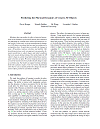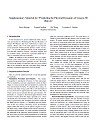Predicting the Physical Dynamics of Unseen 3D Objects
Abstract
Machines that can predict the effect of physical interactions on the dynamics of previously unseen object instances are important for creating better robots and interactive virtual worlds. In this work, we focus on predicting the dynamics of 3D objects on a plane that have just been subjected to an impulsive force. In particular, we predict the changes in state---3D position, rotation, velocities, and stability. Different from previous work, our approach can generalize dynamics predictions to object shapes and initial conditions that were unseen during training. Our method takes the 3D object's shape as a point cloud and its initial linear and angular velocities as input. We extract shape features and use a recurrent neural network to predict the full change in state at each time step. Our model can support training with data from both a physics engine or the real world. Experiments show that we can accurately predict the changes in state for unseen object geometries and initial conditions.
Downloads
Citation
@inproceedings{RempeDynamics2020,
author={Rempe, Davis and Sridhar, Srinath and Wang, He and Guibas, Leonidas J.},
title={Predicting the Physical Dynamics of Unseen 3D Objects},
journal={Proceedings of the Winter Conference on Applications of Computer Vision (WACV)},
year={2020}
}
Acknowledgments
This work was supported by a Vannevar Bush Faculty Fellowship, the AWS Machine Learning Awards Program, the Samsung GRO program, and the Toyota-Stanford Center for AI Research. Toyota Research Institute ("TRI") provided funds to assist the authors with their research but this article solely reflects the opinions and conclusions of its authors and not TRI or any other Toyota entity.



